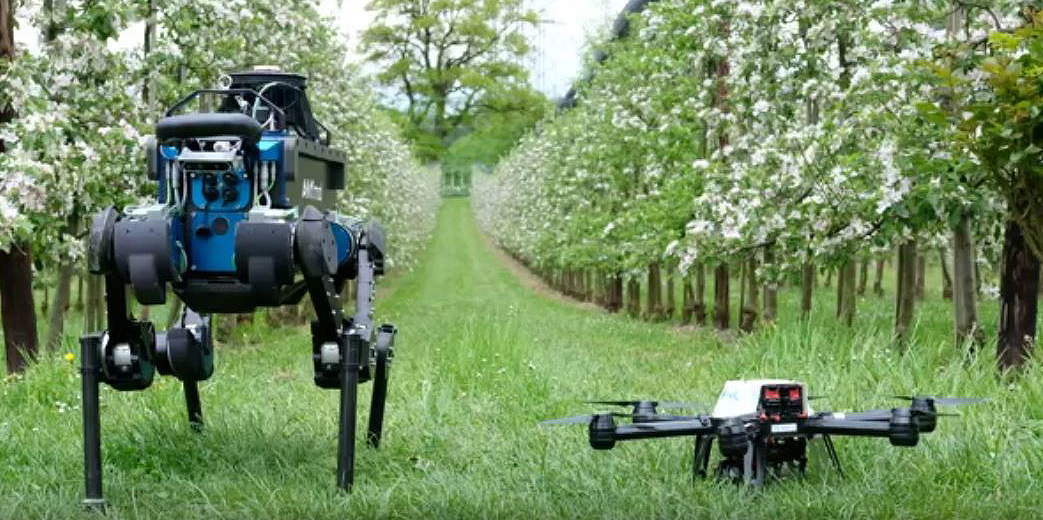It all comes down to the right technology
Agricultural technology doesn’t have a good reputation. And yet, developed intelligently, it’s the key to enhancing sustainability and biodiversity in agriculture, says Achim Walter.

Each spring we marvel as the grass shoots up, flowers bloom and trees burst into life. It's a miracle of nature. Plants produce fruit, seeds and tubers – and all without our help. So you’d think it would be possible to produce the food we eat in a more natural way: with more biodiversity, fewer pesticides and fertilisers, and less human intervention – in other words, less technology. After all, this works in our gardens.
No agriculture without technology
But gardening and agriculture are two very different things. Agriculture without the aid of technology is almost inconceivable in industrialised countries – for it’s only by using ploughs, harrows, field sprayers, drag hose distributors and fertiliser spreaders that most agricultural products can be produced economically and in sufficient quantity.
With crops such as potatoes, cereals, apples and grapes, most of the technology is for spraying the leaves to prevent pests and fungal diseases. And the same goes for organic potatoes and apples. But the copper-containing preparations commonly used here are by no means ecologically harmless. It’s crucial that these and other additives are applied as sparingly as possible.
Precision rather than poison
It’s quite clear to me that innovative agricultural technology must avoid excessive application. And this is where precision farming1 comes in, with the potential to reduce application quantities by 90 percent or more, depending on their purpose2. It does this, for example, by portioning fertiliser, crop protection products and watering according to the vegetation status, and optimising this for each application.
Hands-on research shows that particularly those looking to practise organic farming will need to deploy sophisticated technology3,4 – be it for thoroughly loosening the soil for sowing and growing crops, or mechanically keeping unwanted competitors for light and nutrients in check5.
Equipping tomorrow’s farms

Visionary approaches even claim that plants will no longer be planted at regular intervals in the field, but more densely where conditions permit. Yes, precision farming means one day we’ll be able to cultivate different crops in close proximity and with landscape elements such as hedges – so as to create a near-natural field with a high level of biodiversity5.
But creating and maintaining this type of field will take agricultural machinery quite different from what we’ve seen for decades on our farms. We’d need a number of small, flexible machines that communicate with each other and tend plots and crops in a more differentiated way than before. They would apply data gathered on soil quality, sow geo-referentially, weed mechanically, release nitrogen by sub-region, and deliver an appropriate dose of fertiliser and spray to each plant.
«Such intelligent agricultural technology could also be a driver for the sustainable development of the entire food system.»Achim Walter
A prerequisite here are agile robots and drones capable of recognising images, complemented by sensor networks that keep track of what’s going on in the field and soil – measuring nutrient content, moisture and other relevant parameters. Based on this, geo-referenced maps of soil properties can be used to optimise sowing and to model the future yield potential of the field. Crop production, agroecosystem research, landscape planning and information technology would all have to be interlinked5.
Such intelligent agricultural technology would not only benefit the environment; it would also be a driver for the sustainable development of the entire food system. Cleverly linked data make food potentially traceable, and enhance information on origin, production methods, safety and environmental balance. Indeed, transparency and careful handling of data can boost consumer confidence in agriculture and its products.
All just an agrarian dream?
No, things are already taking shape. At ETH Zurich, we’re carrying out intensive research into digital agriculture and have come up with a number of innovations (see box and video). These include agricultural precision techniques that make it possible to specifically detect weeds and only chop, harrow or spray where absolutely necessary.

So perhaps before long we’ll marvel not only at the awakening of nature in spring, but at the numerous small flying and driving devices tending more natural fields in a coordinated manner.
Achim Walter compiled this blog together with Martijn Sonnevelt.
Agriculture of the future – digital and sustainable?

The AgriTech Day on Saturday 25 May is a field day for all ages and interests in the area of smart farming. Find out how cutting-edge agricultural research and digital technologies are leading to sustainable solutions for Swiss agriculture. Exciting projects, demonstrations and presentations are lined up for you.
Read about the event here
References
1 Finger et al. (2019): external page Precision Farming at the Nexus of Agricultural Production and the Environment
2 Balafoutis et al. (2017): external page Precision Agriculture Technologies Positively Contributing to GHG Emissions Mitigation, Farm Productivity and Economics
3 Informationsportal external page Ökolandbau.de
4 FiBL: external page Video
5 Wegener et al. (2017): external page Neue Pflanzenbausysteme entwickeln – welche innovativen Techniken werden benötigt? Landtechnik 72 (2), 91-100
Comments
No comments yet